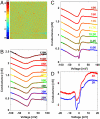Visualizing the formation of the Kondo lattice and the hidden order in URu(2)Si(2)
- PMID: 20498090
- PMCID: PMC2890789
- DOI: 10.1073/pnas.1005892107
Visualizing the formation of the Kondo lattice and the hidden order in URu(2)Si(2)
Abstract
Heavy electronic states originating from the f atomic orbitals underlie a rich variety of quantum phases of matter. We use atomic scale imaging and spectroscopy with the scanning tunneling microscope to examine the novel electronic states that emerge from the uranium f states in URu(2)Si(2). We find that, as the temperature is lowered, partial screening of the f electrons' spins gives rise to a spatially modulated Kondo-Fano resonance that is maximal between the surface U atoms. At T = 17.5 K, URu(2)Si(2) is known to undergo a second-order phase transition from the Kondo lattice state into a phase with a hidden order parameter. From tunneling spectroscopy, we identify a spatially modulated, bias-asymmetric energy gap with a mean-field temperature dependence that develops in the hidden order state. Spectroscopic imaging further reveals a spatial correlation between the hidden order gap and the Kondo resonance, suggesting that the two phenomena involve the same electronic states.
Conflict of interest statement
The authors declare no conflict of interest.
Figures




 , which resembles an asymmetric BCS-like DOS with an offset from EF. V0, γ, and
, which resembles an asymmetric BCS-like DOS with an offset from EF. V0, γ, and  are the gap position (offset from the Fermi energy), the inverse quasi-particle lifetime, and the gap magnitude, respectively. A quasi-particle lifetime broadening of γ ∼ 1.5 mV was extracted from the fits. (C) Temperature dependence of the gap extracted from the fits in A (Black Squares) and from a direct fit to the raw data of Fig. 2C (Blue Circles). Both results are comparable within the error bars. The transition temperature THO = 16.0 ± 0.4 K is slightly lower than the bulk transition temperature presumably as a consequence of the measurement being performed on the surface. (D) Temperature dependence of the gap position Vo extracted from the fits. The line is a guide to the eye.
are the gap position (offset from the Fermi energy), the inverse quasi-particle lifetime, and the gap magnitude, respectively. A quasi-particle lifetime broadening of γ ∼ 1.5 mV was extracted from the fits. (C) Temperature dependence of the gap extracted from the fits in A (Black Squares) and from a direct fit to the raw data of Fig. 2C (Blue Circles). Both results are comparable within the error bars. The transition temperature THO = 16.0 ± 0.4 K is slightly lower than the bulk transition temperature presumably as a consequence of the measurement being performed on the surface. (D) Temperature dependence of the gap position Vo extracted from the fits. The line is a guide to the eye.
References
-
- Stewart G. Heavy-fermion systems. Rev Mod Phys. 1984;56(4):755–787.
-
- Mathur ND, et al. Magnetically mediated superconductivity in heavy fermion compounds. Nature. 1998;394:39–43.
-
- Hewson AC. The Kondo Problem to Heavy Fermions. Cambridge, UK: Cambridge Univ Press; 1993.
-
- Coleman P. Handbook of Magnetism and Advanced Magnetic Materials. Vol 1. New York: Wiley; 2007. Heavy Fermions: Electrons at the edge of magnetism.
LinkOut - more resources
Full Text Sources
Miscellaneous

